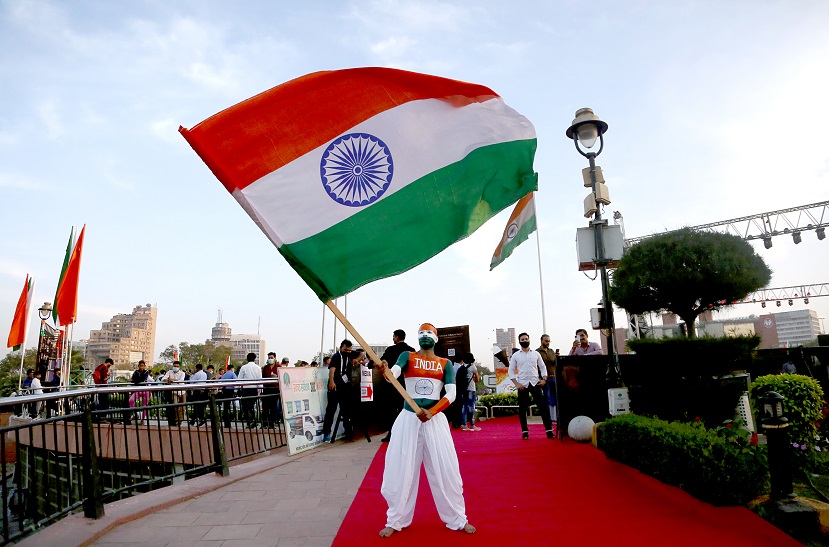The officer who stood up to Rahul Gandhi’s ‘India is not a nation’ assertion at Cambridge University, writes for The Sunday Guardian.
The country that lies north of the ocean and south of the snowy mountains is called Bharata; for there dwell the descendants of Bharat. This is how the Vishnu Purana described India several centuries ago. The same mantra was echoed by Prime Minister Narendra Modi on the floor of Parliament in February, 2022, emphasising on India’s ancient civilisational history and the composite culture and shared values that binds the nation together. But the Vishnu Purana is just one of many ancient texts that mention the term “Bharata” or describe the concept of Bharata as a nation. The word finds mention in the Vedas and epics like Mahabharata. Megasthenes, who travelled extensively in India, describes it in his book “Indica” as being quadrilateral in shape, bound by a great sea from south and east, mountains on the north and river (Indus) on the west. For more than five millennia, though divided politically through constantly altering territorial sovereignties, India’s composite culture remained intact and grew stronger through profound socio-cultural ethos and intense emotional bonds that transcended territorial barriers. Adi Shankaracharya further bolstered Bharata’s socio-cultural and spiritual integrity by establishing four mathas: Badrikashram Jyotirpeetha in the north, Dwarka Shardapeetha in the west, Govardhan Peetha in the east and Sringeri Shardapeetha in the south. It was this integration that propelled kingdoms to defend Bharata from external incursions and ultimately unite the nation to launch a national freedom movement against British colonialism.
But there is another narrative that takes a completely different and rather distorted view of India’s history and nationhood. It considers pre-Independent India as nothing more than a collection of warring kingdoms with no sense of belongingness or identity among the people. In a haste to whitewash India’s rich cultural heritage, the narrative fails to explain how people of these warring kingdoms cooperated and collaborated to create the largest National Freedom Movement against British imperialism. Were the rebels of 1857 or the revolutionaries of Hindustan Socialist Republican Association or the young men and women of Subhas Bose’s Indian National Army fighting to defend regional and parochial interests?
When the historical arguments expose glaring inadequacies, the narrative takes refuge of a selective interpretation of the Constitution of India and the circumstances surrounding the process to integrate Princely States post 15 August, 1946. The argument put forth is that Article 1 of the Constitution of India states that India, that is Bharata shall be a Union of States. As it mentions the term “Union of States” India must not be a nation. It is further claimed that India was a result of negotiated peace and agreements between States. The argument is rife with inaccuracies as it stems from a misunderstanding of the quasi-federal structure of Indian polity. Dr B.R. Ambedkar, Chairman of the Drafting Committee of the Constitution, spoke on this at length. Alas, those who are determined to twist constitutional facts are either oblivious or deliberately ignoring his speeches. Dr Ambedkar, whilst clarifying the committee’s decision to use the term “Union of States” said, “I can tell you why the drafting committee has used it (the term ‘Union’). The Drafting Committee wanted to make it clear that though India was to be a Federation, the Federation was not the result of an agreement by the States to join in a Federation and that the Federation not being the result of an agreement no State has the right to secede from it. The Federation is a Union because it is indestructible. Though the country and the people may be divided into different States for convenience of administration the country is one integral whole.” It is clear that India is not a result of an agreement between States and the founding fathers did not intend to constitute India as a federation in the American sense. Article 2 of the Constitution empowers Parliament to admit or create new States pointing towards a Unitary bias. The Preamble which embodies our core constitutional values mentions the term “Nation” as well. Reading Article 1 that merely enumerates India’s territories in isolation is a glaring violation of the doctrine of harmonious construction.
Independent India has been a remarkable success story as it is one of the very few post-colonial nations founded on liberal democratic ideals and that ensures freedom of speech and expression in an extremely large and diverse population. The source of these ideals is not the Constitution as it merely recognises these rights. These ideals can be traced back to the Rig Veda which says, “Ekam Sat Vipra Bahudha Vadanti” i.e. truth is one, but the wise call it by many names. Or the long tradition of debate or Shastrarth which saw Adi Shankaracharya locked in a legendary debate with Mandana Misra for over 15 days.
The idea of Bharata’s nationhood, whilst strongly supported by historical and constitutional facts, is best felt by those who consider themselves children of this ancient miracle. Regardless of where one goes in India, there exists a deep socio-cultural and emotional bond that runs beneath a vast diversity. These values and ethos have enabled Bharata survive centuries of onslaughts and they shall enable it to take its rightful place in the 21st century world.
Siddhartha Verma is an Indian civil servant and a Commonwealth Scholar in Public Policy at the University of Cambridge. Views are personal.

